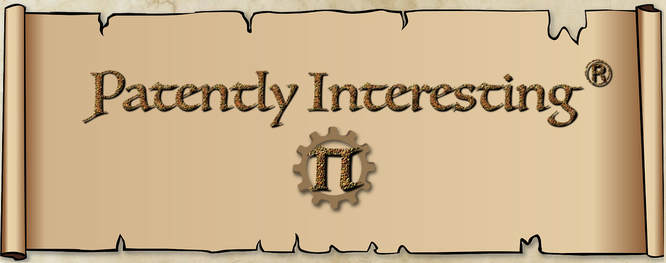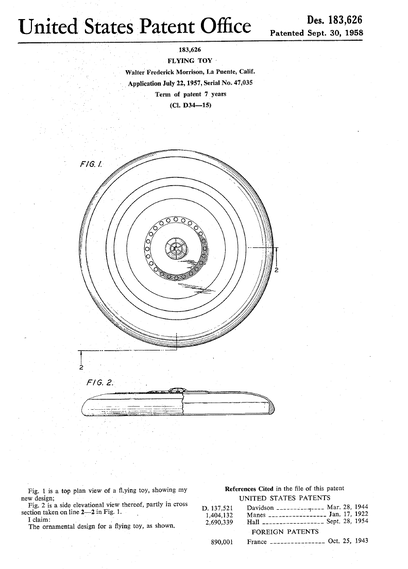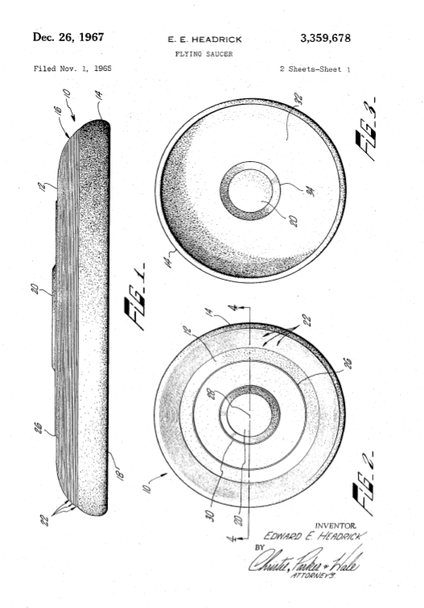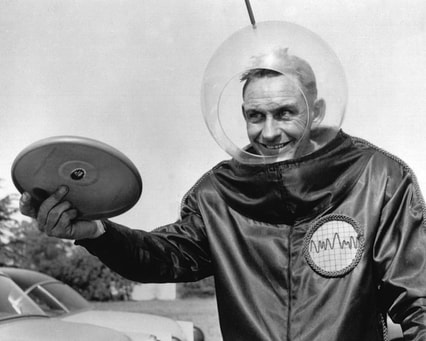 Fred Morrison with his "Pluto Platter"
Fred Morrison with his "Pluto Platter"
On September 30 of the year 1958, U.S. Design Patent No.: 183,626 issued to Walter Frederick Morrison of La Puente, California for "Flying Toy". The design was for a precursor of the Frisbee® flying disk, which Morrison was selling at the time under the name "Pluto Platter". Earlier, as a young man, Morrison, together with his future wife, Lucile, had discovered that the lid for a 5-gallon tub of popcorn flew surprisingly well and was fun to throw around. When the popcorn lid became too banged up for further use, Morrison progressed to cake pans, which he discovered flew even better. One day, while at the beach tossing around a cake pan, Morrison was approached by a spectator who wanted to buy the cake pan for a premium over what Morrison had paid. Seeing a business opportunity, Morrison started selling cake pans at Santa Monica beach. However, his fledgling business was soon interrupted when he joined the U.S. Air Force during World War II.
During the war, Morrison flew a P-47 in the European theatre. While flying on a mission over the Po valley in Italy, Morrison was shot down and taken prisoner. When the war ended, Morrison returned home and began work as a carpenter. At night, however, he worked on developing a new type of flying disk, one that was made from plastic. Morrison enlisted the help of a fellow Air Force veteran, Warren Franscioni, to bring the plastic flying disk to market. Together, Morrison and Franscioni formed a company called Pipco, which started selling the world's first plastic flying disk in 1948. The disk was called the "Flyin-Saucer" to take advantage of the flying saucer craze that was sweeping the nation after the famous sighting by pilot Kenneth Arnold of nine "flying saucers" near Mount Rainier, Washington in 1947.
Pipco was short lived and by 1950 was out of business, with Morrison and Franscioni going their separate ways. Morrison, however, did not give up. He formed a new company called American Trends and redesigned the "Flyin-Saucer" to be more aerodynamic. He removed the spiral vanes that had been molded into the outer surface of the "Flyin-Saucer" in the mistaken belief that they would help with lift. He also changed the radial slope of the disk and increased the thickness of its outer rim such that its interior surface was mostly vertical, with a slight inward slope. The outer third of the disk (known as the "Morrison slope") essentially formed an airfoil that greatly improved the lift of the disk.
In 1955, Morrison started selling his redesigned disk as the "Pluto Platter". In addition to having the Morrison slope, the "Pluto Platter" had a small dome with portholes at its center and the names of the planets embossed around its outer circumference. In 1957, Morrison filed a design patent application for the "Pluto Platter" (without the planet names). The application issued in 1958 as the '626 design patent.
In 1956, Morrison contacted another California company, the Wham-O Manufacturing Co., to see if they had any interest in his "Pluto Platter". Needless to say, they did, and an arrangement was quickly worked out. Wham-O started selling the "Pluto Platter" in 1957, with Morrison receiving a royalty for each sale.
During the war, Morrison flew a P-47 in the European theatre. While flying on a mission over the Po valley in Italy, Morrison was shot down and taken prisoner. When the war ended, Morrison returned home and began work as a carpenter. At night, however, he worked on developing a new type of flying disk, one that was made from plastic. Morrison enlisted the help of a fellow Air Force veteran, Warren Franscioni, to bring the plastic flying disk to market. Together, Morrison and Franscioni formed a company called Pipco, which started selling the world's first plastic flying disk in 1948. The disk was called the "Flyin-Saucer" to take advantage of the flying saucer craze that was sweeping the nation after the famous sighting by pilot Kenneth Arnold of nine "flying saucers" near Mount Rainier, Washington in 1947.
Pipco was short lived and by 1950 was out of business, with Morrison and Franscioni going their separate ways. Morrison, however, did not give up. He formed a new company called American Trends and redesigned the "Flyin-Saucer" to be more aerodynamic. He removed the spiral vanes that had been molded into the outer surface of the "Flyin-Saucer" in the mistaken belief that they would help with lift. He also changed the radial slope of the disk and increased the thickness of its outer rim such that its interior surface was mostly vertical, with a slight inward slope. The outer third of the disk (known as the "Morrison slope") essentially formed an airfoil that greatly improved the lift of the disk.
In 1955, Morrison started selling his redesigned disk as the "Pluto Platter". In addition to having the Morrison slope, the "Pluto Platter" had a small dome with portholes at its center and the names of the planets embossed around its outer circumference. In 1957, Morrison filed a design patent application for the "Pluto Platter" (without the planet names). The application issued in 1958 as the '626 design patent.
In 1956, Morrison contacted another California company, the Wham-O Manufacturing Co., to see if they had any interest in his "Pluto Platter". Needless to say, they did, and an arrangement was quickly worked out. Wham-O started selling the "Pluto Platter" in 1957, with Morrison receiving a royalty for each sale.
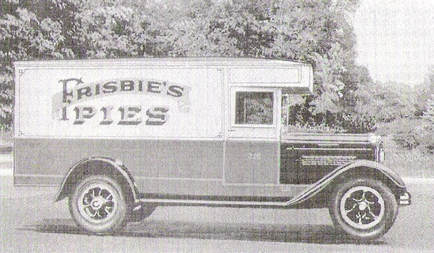 Frisbie Pie Truck
Frisbie Pie Truck
While on a marketing trip to the east coast, the owners of Wham-O heard children refer to tossing the "Pluto Platter" as "Frisbie-ing". The term was derived from the Frisbie Pie Co. of Bridgeport, Connnecticut, whose pie tins had long been used as flying disks in the New England area, particularly at Yale University. Wham-O liked the sound of the name and in 1957, decided to use a version of it, i.e., "Frisbee" in conjunction with the marketing and sale of the "Pluto Platter". In 1959, Wham-O received a trademark registration for Frisbee® for "toy flying saucers for toss games". The name "Pluto Platter" was dropped from the product in 1964.
The retirement of the "Pluto Platter" name was part of a change in marketing for the Frisbee® flying disk that was being implemented by Wham-O's new general manager and head of marketing, Ed Headrick, who wanted to market the flying disk to young adults as a sports product, rather than as a toy for children. In conjunction with this change in marketing, Headrick redesigned the Frisbee® flying disk to remove the dome and the planet names and to include a series of concentric rings. On December 26, 1967, Headrick received a patent (U.S. Patent No.: 3,359,678) for a flying disk with concentric rings, which have become known as the "Rings of Headrick". The rings were claimed to improve the flight performance of the flying disk by increasing its speed and stability.
With Headrick's modifications to Morrison's "Pluto Platter", the evolutionary path to the modern Frisbee® was complete.
The retirement of the "Pluto Platter" name was part of a change in marketing for the Frisbee® flying disk that was being implemented by Wham-O's new general manager and head of marketing, Ed Headrick, who wanted to market the flying disk to young adults as a sports product, rather than as a toy for children. In conjunction with this change in marketing, Headrick redesigned the Frisbee® flying disk to remove the dome and the planet names and to include a series of concentric rings. On December 26, 1967, Headrick received a patent (U.S. Patent No.: 3,359,678) for a flying disk with concentric rings, which have become known as the "Rings of Headrick". The rings were claimed to improve the flight performance of the flying disk by increasing its speed and stability.
With Headrick's modifications to Morrison's "Pluto Platter", the evolutionary path to the modern Frisbee® was complete.

